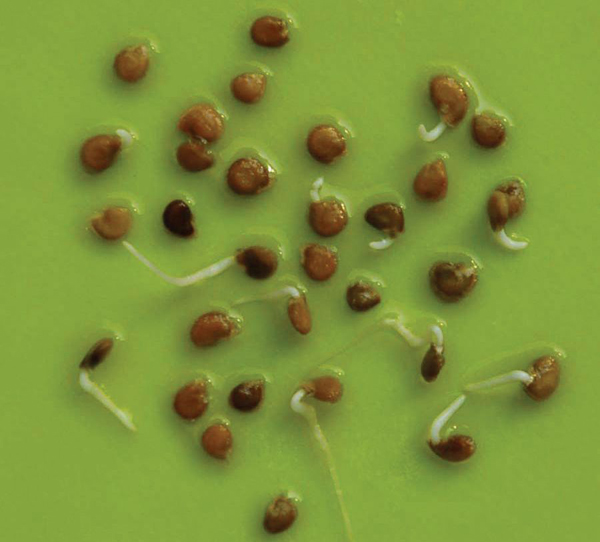
Chapter 6
Starting Your Seeds
Many consider an early start to be very important. This is true for gardeners who are growing tomatoes to eat, as well as those who want their plants to be large at the time of planting – with the hope that a larger plant will lead to a larger tomato. Seeds are usually started around 6 to 8 weeks before the grower's final frost date. Those aiming for a specific harvesting date, such as a county fair or other contest, might choose to start their plants based on the date of the event (See the Chapter on Timing Your Tomatoes.)
Plant two to three times as many seeds as you want plants, since not all of the seeds will germinate, and also so you can later select only strong plants. Choose the largest seeds you have because they are more likely to be mature. However, seed size does not determine viability. Later, you will easily see which plants have the most potential. Tomato seeds will germinate on average in 5 to 10 days depending on your germination setup.
Seeds can be started in any container that has a hole in the bottom for drainage. Some growers prefer Styrofoam or plastic drinking cups (5 or 7 ounce cups work well) with holes poked in the bottom for drainage. An advantage of using a cup is that you can write the name of the tomato variety on its side. Just about any container will work as long as excess water can drain. It is a good idea to provide some sort of covering for your containers to preserve moisture during germination. You can place the container in a plastic bag, cover it with clear wrap, or put it in some sort of enclosure. Do not allow the growing mix to dry out as dry seeds will not germinate.
For a growing medium, a commercially prepared seed starting mix, usually a sterile combination of peat moss, vermiculite, and perlite, is best. Avoid mixes that have a high fertilizer content. Combine the seed starting mix thoroughly with warm water to bring it to a useable state. The final mix should be damp like a squeezed out sponge, not soaked or soggy.
You can choose to plant one seed per container or numerous seeds close together in a larger container, later moving them to individual pots after the first true leaves appear. Plant the seeds 1/3 of an inch deep. Place your pots in an incubator at 70˚ to 80˚, or use a container with bottom heat via a heating mat. Germination is delayed by lower temperatures and accelerated by higher temperatures. Temperatures below 50˚ and above 95˚ are detrimental to germination. Tomato seeds will germinate in anything as long as the seeds get moisture and warmth, but not too much of either.
After you germinate your seeds, keep a close eye on the seedlings. They will need bright light as soon as they emerge, 12 to 16 hours of light per day if possible. Very strong light is needed to support tomato growth. You will most likely need artificial lighting with grow lights. Many growers use inexpensive fluorescent lights that are kept two, and no more than four, inches from the leaves of the plants. Further away and fluorescent lighting does not work. Halogen grow lights generate lots of heat and may burn the plants if too close. A south-facing window sill will work but usually not as well as grow lights. A heated green house is the ultimate location to continue growing your seedlings. Another choice is a cold frame with supplemental heat for cold nights.
Grower Comments on Seed Starting
"I use Solo cups or similar from the food store. I personally think 5 ounce plastic cups are best. I only put about 1 to 2 inches of soil in the cup then keep adding soil as they grow. It saves transplanting. Just don't forget the hole in the bottom. As soon as the seed sprouts on a paper towel, I carefully place it on top of the soil in the plastic cup. I leave it one more day on the heat covered in the cups. Keep them just moist. The next day they should look well sprouted. I then place them under lights and baby them. I spritz them lightly with my chamomile tea mix to prevent damping off. However, with sterile soil I don't think that should be a problem. Make sure that when you place the seeds in the cups that they are in a slight depression and have good contact with the soil. Then sprinkle some fresh soil on top, still allowing the sprout to show. With the proper heat, they usually sprout within a few days." Minnie Z.
"I start my seed in the basement using a mini-propagator with heating mat that you can buy at most garden stores. I place a small flat container of water in the propagator. Next to it I place a dish containing a moist filter paper with seeds on top and clear wrap on top of that. The lid of the mini-propagator holds all of the moisture in. Once I see the seeds sprout, I remove them from the dish with tweezers and place them in 7 ounce plastic cups in a slight indentation in the starting mix that is moist but not wet. Then, I cover the sprouting seeds very slightly with the moistened mix. The bottom of the cup has been perforated to allow drainage and also to allow for watering. They remain in the propagator until they show through the soil and I can see a leaf." Marv M.
